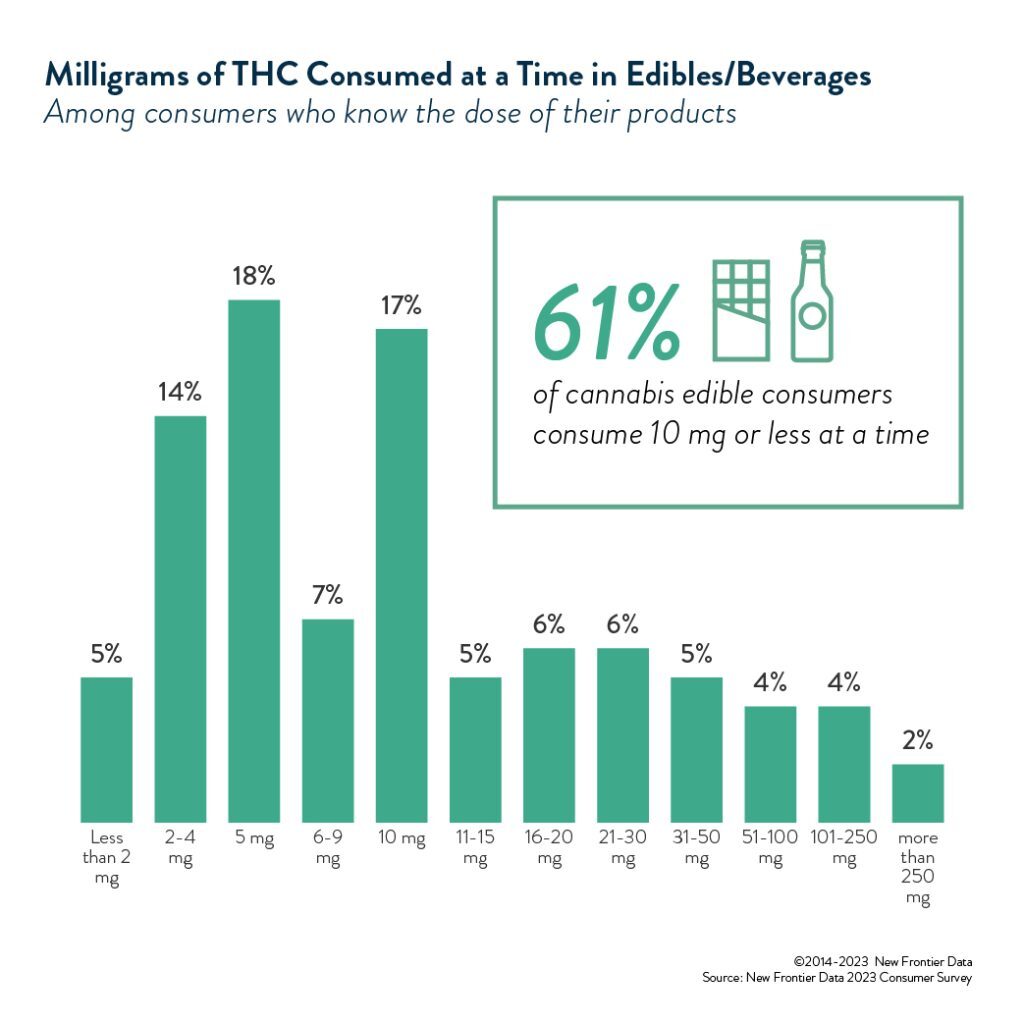Rethinking Cannabis Potency: Are Low Dose Products the Appropriate Choice for Most Consumers?

U.S. Cannabis Sales Could Total $71B in 2030 Without Federal Legalization
March 22, 2023
Expansion of legalization across U.S. states provides pockets of momentum despite North American M&A activity being down significantly in 2022
April 18, 2023By Dr. Molly McCann, Senior Director of Consumer Insights at New Frontier Data
The cannabis industry has evolved tremendously in recent years, with an increasing number of consumers seeking out a variety of products to satisfy their unique needs and preferences, and a broadening of product offerings to cater to diverse needs among consumers. New Frontier Data’s recent survey data suggests that high-potency offerings (high in THC) may not be suitable for most people.
Cannabis has a wide range of effective doses across different populations—more than other commonly used drugs like coffee and alcohol. Some people can feel the effects of just 1 mg of THC, while others cannot notice any effects below 20 or 30 mg of THC. While alcohol and caffeine tolerance also vary somewhat between people, a 30x difference in effective dose of wine or coffee is unimaginable.
Many adults today had their first experience with cannabis during prohibition, where information about the cannabis they were consuming was extremely limited, and where the iron rule of prohibition favored products of the highest potency possible. Product options were generally limited to flower and homemade edibles, where potency was often unknown, and could vary dramatically from one side of the brownie baking sheet to the other.
Such unpredictable potency has left many with stories of their early experimentation with cannabis that include paranoia, nausea, or full-on hallucinations. Some people end their relationship with cannabis there, not wanting to risk another negative experience.
I have many friends and family members who had previously sworn off cannabis after too intense an experience but have recently been introduced to new low-dose products like Cann beverages or Kiva’s Petra mints and are surprised to be enjoying cannabis for the first time. My hypothesis is that many people who tried cannabis in the past and had a bad experience took a dose much higher than their minimum effective dose, and that most people should probably be taking products with less THC, or what the industry calls “low dose”. Because of this, low-dose products have incredible long-term potential, not only for future consumers but as a way of bringing some former consumers back around to cannabis.
Many current edible and beverage consumers prefer low doses.
Among edible and beverage consumers who have information about the dose of their product, 19% consume less than 5 mg of THC at a time, and 18% consume 5 mg at a time. A majority—61%—consume 10 mg or less at a time. While this doesn’t necessarily mean that 10 mg or less is the appropriate dose for a majority of cannabis consumers, it does provide insight into the preferences of a significant portion of the market.
Notably, many consumers who require higher doses to feel the effects of cannabis often avoid edibles and opt for higher potency—and therefore more cost-effective—product forms like concentrates. However, edibles are used by a majority of consumers (58%), indicating that there is a sizable market for lower-dose cannabis products.
A significant portion of former consumers had very limited experience with cannabis before quitting.
In order to tap into a larger market, it’s worth considering the preferences and experiences of former cannabis consumers—those who have tried cannabis but said they will not use it again. Among this group, more than a third (35%) say they only ever tried cannabis once or twice. When asked why they gave up using cannabis, 37% of former consumers said they disliked the feeling of being high, and 31% said they disliked a side effect of the cannabis, such as dry mouth or paranoia. These reasons inherent to the experience itself far outranked most external factors for quitting, such as conflicts with professional or personal responsibilities (16% and 14%, respectively).
There is a significant business opportunity to win back these low-experience former consumers, but doing so will require extensive education, reassurance, and transparency to shift their perspective on cannabis and its effects. By offering low-dose products that minimize the risk of negative side effects and the intensity of the high, companies can cater to this market segment and potentially convert some into regular consumers.
To effectively target former consumers, as well as hesitant potential consumers, it will be essential for the industry to prioritize education and transparency. This can be achieved through:
|
Clear labeling |
Ensuring that products have easy-to-understand labels that accurately display the potency and dosage information will allow consumers to make informed decisions about which products are best suited to their unique needs. |
|
Education |
Educational campaigns that focus on responsible consumption, the benefits of lower dose products, and the natural variation between people in their sensitivity to THC will reduce the number of negative experiences among new users. |
|
Staff training |
Budtenders must be given the knowledge and support to guide customers towards appropriate products. Many budtenders are heavy users with higher tolerances than average who might have limited personal experience with low-dose products and therefore need to be informed about products they are not personally interested in. |
|
Legalization |
The expansion of legal, regulated markets will result in more consumers having
|







